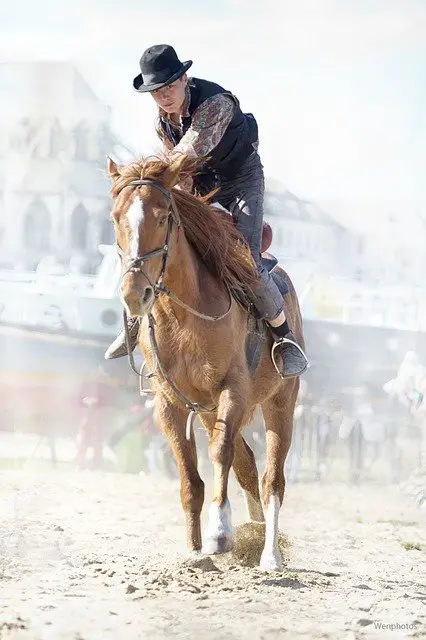Last Updated on March 8, 2022 by Allison Price
Vaulting involves performing graceful dance moves or gymnastic moves while riding on a horse. Vaulting is a sport that improves balance, coordination, and self-confidence.
Basics of Vaulting
A vaulting team consists of a horse, a longeur and at least one vaulter. Individual vaulters, pairs, and teams compete. Mixed males and women can form teams.
The enclosed arena is soft-footed and vaulters perform there. The longeur, a member of the team, stands in the middle and attaches a longe line to the horse. The longeur controls the horse’s movements, which can be either a trot, walk or trot depending on the competition level. Vaulting is safer than trick riding because the longeur controls the horse.

The vaulters dance to the music. Vaulters wear tight, stretchy uniforms that are not loose and can cause injury if they get caught. To avoid hair entanglement, they keep their hair neat. The soft-soled, leather shoe called Footwear is similar to the ballet slippers.Learn More
Appropriate Horses
Vaulting horses can be of any size or breed, but draft or wide-based breeds are the most popular. The vaulting horse must have a calm, kind personality and be consistent in their movements. The American Vaulting Association (AVA), stipulates that horses must have at least six years of age and that stallions are prohibited.
Essential Equipment
You will need a range of equipment to play the sport.
- Performers First Choice Vaulting SurcingleVaulting surcingle – A vaulting surcingle This is a long leather strap that rests behind the horses withers. There are two handles (called grips) and two leather straps (called cossacks). The outside has several metal D rings. While performing gymnastic moves, the vaulter uses the cossacks and grips. The longeur attaches the side reins to both the D-rings. The vaulting surcingle is located just behind the withers and the girth lies in the groove between the horse’s front feet.
- Bridle The horse wears a leather-bridle and a smooth bit.
- Side Reins One end attaches to a bit, the other to the D rings on the surcingle. Side reins allow the horse to keep his body straight, balanced and move in a circle around longeur.
- Longeline – The longe line, made of nylon or cotton, has a snap at one end that attaches on the horse’s near side. Longe lines can be 10 meters in length, which allows horses to move in a circle of 20 meters. The horse vaults in a 15-meter circle. Therefore, the longeur holds the longe at 7.5 meters instead of at the end.
- Longe whip The longe whip measures six to ten feet in length and has a lash at the end. The lash must reach the horse, as the longeur is in the middle.
- Equipment Optional These equipment pieces can be used in competition by the AVA
- Protect the legs of your horse with wraps or bandages
- Breastplate to prevent the surcingle’s slide back
- No more than 2 inches thick felt back pad
- Horse earplugs and earmuffs
Vaulting Competitions
Vaulting is an international sport that is sanctioned by International Equestrian Federation. The FEI World Cup and FEI World Equestrian Games are the venues for top-level competitions.
The AVA, the United States’ governing agency for this sport, is located in Washington. AVA’s website has a calendar of contests. You can also find forms to help you organize competitions.
Compulsory Portion in a Competition
Competitors compete in both compulsory and freestyle classes. All vaulters perform the same movements and in the same order in the compulsory section.
Freestyle vaulting
Freestyle is more artistic and vaulters choreograph unique movements to show their talent.
Getting Started
AVA has 141 clubs that are sanctioned in the United States. It also maintains a list of trainer contact information and a current list. To learn vaulting, potential vaulters don’t need to be able to ride horses. Beginning vaulters learn to move on a stationary barrel first before moving onto a horse. Beginning at a walk, vaulters move to a trot or canter.
The horses and equipment are owned by the teams, not the vaulters. This allows vaulters to participate in horse care without having to board the horse. Keep these other points in mind:
- Vaulters must be fit. To avoid injuries, most training sessions begin with stretching and quick runs.
- For practice sessions, tight-fitting tops and athletic leggings are ideal. Layers are recommended for practicing in cold temperatures.
- Vaulters can practice in soft-soled shoes but it is important to bring boots for practice sessions. Team horses are often cared for by vaulters before and after practice.
- Trust is essential for vaulting. When working together with horses, vaulters must trust each other. They also need to trust the longeur in order to keep the horses moving at a steady pace.
- Vaulters are not like horses and point their toes instead of keeping their heels down.


